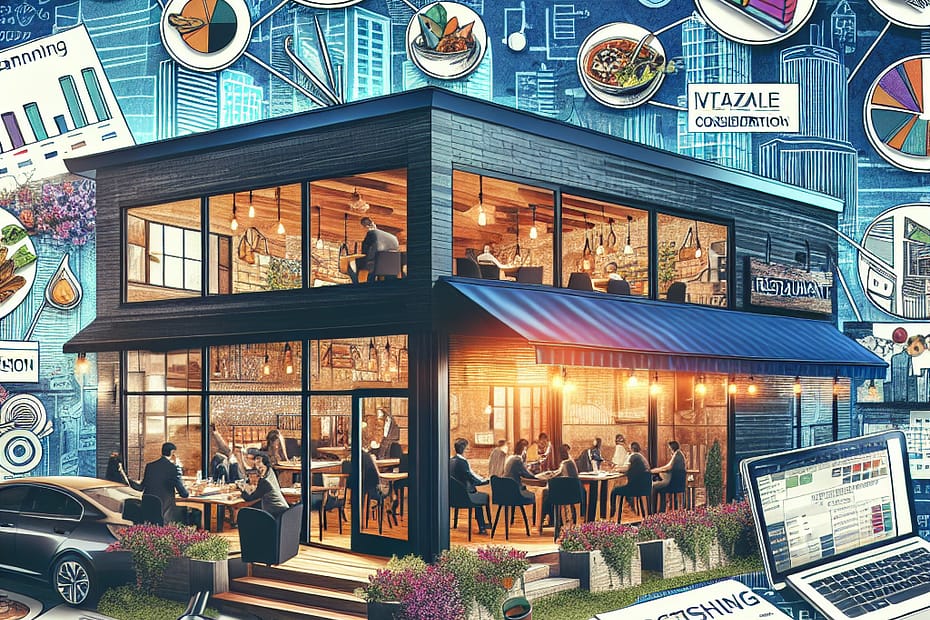Congratulations! You’ve taken the first step towards turning your dream of owning a thriving restaurant into a reality. Embarking on the journey of starting a successful restaurant business from scratch can be both exciting and intimidating, but fear not! In this article, we will provide you with valuable insights and practical tips on how to navigate the challenges and capitalize on the opportunities that come your way. So, grab a cup of coffee, take a deep breath, and let’s begin this exhilarating adventure together.
Choose a Restaurant Concept
Identify your target audience
Before starting a restaurant business, it is important to identify your target audience. Who do you want to serve? Consider factors such as age, income level, and preferences. Understanding your target audience will help you tailor your concept and menu to their tastes and needs.
Consider your personal expertise and interests
When choosing a restaurant concept, it is important to consider your personal expertise and interests. What are you passionate about? What are your skills in the culinary world? Choosing a concept that aligns with your strengths and interests will increase your chances of success and make the business more enjoyable for you.
Research current market trends
To stay competitive in the restaurant industry, it is crucial to research current market trends. Stay up to date with the latest food and dining trends, as well as consumer preferences. This will help you develop a concept that is in demand and appeals to your target audience.
Develop a Business Plan
Define your mission and vision
Start by defining your restaurant’s mission and vision. What is the purpose of your restaurant? What values will it embody? Your mission and vision will guide all aspects of your business, from menu development to employee hiring.
Set specific goals and objectives
Setting specific goals and objectives is essential for the success of your restaurant. Determine what you want to achieve in terms of revenue, customer satisfaction, and growth. These goals will help you create a roadmap for your business and measure your progress.
Analyze your competition
Analyzing your competition is crucial to understand the market landscape and identify unique selling points for your restaurant. Study other restaurants in your area that cater to a similar target audience and analyze their strengths and weaknesses. This will help you differentiate your business and offer something that sets you apart.
Create a detailed financial plan
Developing a detailed financial plan is essential for the success of your restaurant business. Consider expenses such as equipment, rent, permits, and marketing. Calculate projected revenues and create a budget that allows for profit margins while ensuring sustainability.
Outline your marketing and branding strategy
A well-defined marketing and branding strategy is key to attracting customers and building a strong brand image. Determine how you will promote your restaurant, whether through social media, partnerships with local influencers, or traditional advertising. Additionally, create a cohesive brand identity through the use of logos, colors, and slogans.
Find the Right Location
Determine your target market’s location preferences
Understanding your target market’s location preferences is crucial when choosing a location for your restaurant. Consider factors such as convenience, population density, and proximity to other businesses or attractions that your target audience may be interested in.
Consider accessibility and parking options
Ensure that your chosen location is easily accessible for your target audience. Consider proximity to major roads or public transportation options. Additionally, parking availability should be taken into account to provide a convenient experience for customers.
Evaluate the competition in the area
Evaluating the competition in the area is important to determine if there is demand for your concept. Research other restaurants in the vicinity and consider their offerings, pricing, and popularity. This information will help you gauge if there is room for your business to thrive.
Calculate the potential foot traffic
Assessing the potential foot traffic in the area will give you an idea of the number of potential customers passing by your restaurant. High foot traffic can lead to increased visibility and more customers. Consider factors such as nearby offices, shopping centers, or tourist attractions that may attract people to the area.
Obtain the Necessary Permits and Licenses
Research and acquire the appropriate licenses and permits
Before opening your restaurant, it is crucial to research and acquire the necessary licenses and permits. This may include a business license, food service license, liquor license, and health department permits. Compliance with legal requirements will ensure a smooth operation and avoid potential penalties.
Consult with local authorities and health departments
To ensure you have all the required permits and licenses, consult with local authorities and health departments. They can provide guidance on the specific requirements for your location and help you navigate the application process. Building a positive relationship with these organizations is important for maintaining compliance.
Design an Attractive Restaurant Space
Create an appealing interior design
The interior design of your restaurant plays a significant role in attracting customers and creating a memorable dining experience. Choose a theme or aesthetic that aligns with your concept and target audience. Consider elements such as lighting, colors, and overall ambiance to create a welcoming atmosphere.
Choose appropriate furniture and decor
Selecting appropriate furniture and decor is essential to create a comfortable and visually appealing space. Choose furniture that complements the overall design and ensures the comfort of your customers. Decorate the space with artwork or objects that reflect your concept and add personality to the restaurant.
Consider the layout and flow of the space
Take into consideration the layout and flow of the space when designing your restaurant. Ensure that there is enough space for customers and staff to move around comfortably. Optimize the layout to maximize seating capacity while maintaining a balance between functionality and aesthetics.
Ensure functionality and efficiency for staff and customers
Functionality and efficiency are key considerations in the design of your restaurant space. Ensure that the kitchen layout allows for smooth operations, with proper workstations and equipment placement. Additionally, consider the needs of your customers, such as accessible restrooms and efficient service areas.
Develop a Menu
Determine your restaurant’s cuisine style and theme
Decide on the cuisine style and theme for your restaurant. Consider your target audience’s preferences and the current market trends. Choose a theme that will resonate with your customers and differentiate your restaurant from competitors.
Research and create a diverse menu
Research and create a diverse menu that caters to your target audience’s tastes. Include a variety of appetizers, main courses, desserts, and beverage options. Consider different dietary preferences, such as vegetarian or vegan dishes, to appeal to a wider audience.
Consider dietary restrictions and preferences
Take into account dietary restrictions and preferences when developing your menu. Consider offering gluten-free options, low-sodium dishes, or allergen-friendly alternatives. Accommodating various dietary needs will ensure that all customers can enjoy their dining experience at your restaurant.
Source high-quality ingredients
Using high-quality ingredients is essential to provide customers with a great dining experience. Establish relationships with local suppliers and prioritize fresh and locally sourced ingredients. This will ensure the quality of your dishes and support local producers.
Hire and Train a Competent Team
Define your staffing needs
Before hiring your team, define your staffing needs. Determine the number of employees required for each role, such as chefs, servers, bartenders, and dishwashers. Consider the expected volume of customers and the complexity of your menu when determining staffing levels.
Recruit and select skilled employees
Recruit and select skilled employees who align with your restaurant’s mission and values. Look for individuals with experience in the industry and a passion for hospitality. Conduct thorough interviews and consider conducting practical assessments to assess skills and personality fit.
Provide comprehensive training programs
Once you have assembled your team, provide comprehensive training programs to ensure consistency and quality in service. Train employees on food safety, customer service skills, menu knowledge, and operating procedures. Ongoing training and development opportunities will help maintain a high level of performance.
Establish clear roles and responsibilities
Establish clear roles and responsibilities for each member of your team. Clearly define job descriptions and expectations to avoid confusion and ensure smooth operations. Encourage open communication and teamwork among your staff to foster a positive work environment.
Create Strong Supplier Relationships
Find reliable and high-quality ingredient suppliers
Finding reliable and high-quality ingredient suppliers is crucial for the success of your restaurant. Research local suppliers and build relationships based on trust and consistency. Regularly evaluate the quality of their products and maintain open communication to address any issues or changes in your needs.
Negotiate favorable pricing and terms
When establishing supplier relationships, negotiate favorable pricing and terms for your restaurant. Take advantage of opportunities for bulk purchasing or seasonal discounts. Building a mutually beneficial relationship with your suppliers will help you secure the best prices for high-quality ingredients.
Maintain consistent communication and re-evaluate suppliers regularly
Consistent communication with your suppliers is important to stay updated on product availability, pricing changes, or any challenges they may face. Regularly re-evaluate your suppliers to ensure they continue to meet your needs and maintain the quality standards of your restaurant.
Implement Effective Marketing Strategies
Utilize social media platforms for promotion
Utilize social media platforms to promote your restaurant and engage with your target audience. Create enticing content, share updates on menu changes or special events, and encourage customers to leave reviews. Leverage social media advertising options to reach a wider audience.
Offer attractive special deals and discounts
Attract customers by offering special deals and discounts. Consider promotions such as happy hours, lunch specials, or loyalty programs. These offers incentivize customers to choose your restaurant over competitors and encourage repeat business.
Collaborate with local influencers or food bloggers
Collaborate with local influencers or food bloggers to increase your restaurant’s visibility and credibility. Invite them for tastings or offer them exclusive experiences to promote your restaurant to their followers. Their positive reviews and recommendations can have a significant impact on attracting new customers.
Maintain a strong online presence
Maintaining a strong online presence is crucial in today’s digital age. Regularly update your website with current menus, contact information, and online ordering options. Respond to customer reviews and feedback promptly and professionally to show that you value their input.
Provide Exceptional Customer Service
Train staff on excellent customer service skills
Providing exceptional customer service should be a top priority for your restaurant. Train your staff on excellent customer service skills, including attentiveness, friendliness, and problem-solving. Encourage them to go the extra mile to exceed customer expectations.
Create a welcoming and comfortable atmosphere
Create a welcoming and comfortable atmosphere in your restaurant to make customers feel at home. Pay attention to the little details, such as lighting, music, and temperature, to ensure a pleasant dining experience. Greet customers with a friendly smile and make them feel valued and appreciated.
Address customer feedback and complaints promptly
Promptly address customer feedback and complaints to show that you care about their experience. Train your staff to handle complaints professionally and resolve issues to the customer’s satisfaction. Use constructive feedback to improve your operations and maintain a positive reputation.
Build strong relationships with regular customers
Building strong relationships with regular customers is key to the success of your restaurant. Show appreciation for their loyalty through personalized experiences or rewards programs. Engage with them on a regular basis, remembering their preferences and offering tailored recommendations. These loyal customers will become ambassadors for your restaurant and recommend it to others.
By following these comprehensive steps, you can start a successful restaurant business from scratch. Remember to continuously adapt and evolve to meet the changing demands of the industry and your target audience. With dedication, passion, and a strong business plan, your restaurant can thrive and become a popular destination for food lovers.





